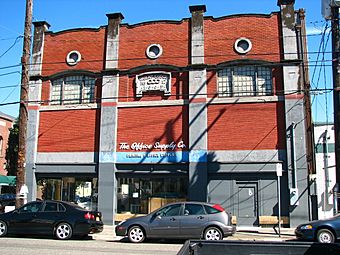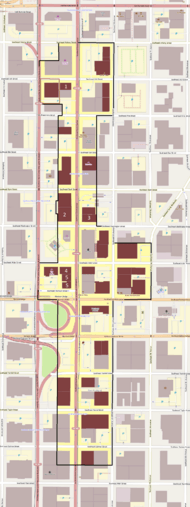East Portland Grand Avenue Historic District facts for kids
|
East Portland Grand Avenue Historic District
|
|

The Orient Lodge, a contributing resource in the East Portland Grand Avenue Historic District, in 2009
|
|

Location of the historic district in Portland
|
|
| Location | Bounded by Main and Ankeny Sts, SE 7th Ave and SE Martin Luther King, Jr. Blvd (SE Union Ave), Portland, Oregon |
|---|---|
| Area | 28 acres (11 ha) |
| Architectural style | Colonial Revival, Art Deco, Italianate |
| NRHP reference No. | 91000126 (original) 13001066 (increase) |
Quick facts for kids Significant dates |
|
| Added to NRHP | March 4, 1991 |
| Boundary increase | December 5, 2013 |
The East Portland Grand Avenue Historic District is a special area in Portland, Oregon. It is found in southeast Portland, near the Willamette River. This district is important enough to be on the National Register of Historic Places. This means it has historical value and is protected.
The district covers about 20 city blocks. It is located around Southeast Grand Avenue. Most buildings here are commercial, meaning they were used for businesses. They are usually two or three stories tall.
Contents
History of East Portland's Grand Avenue
This historic district is part of a bigger area. It was first called the East Portland Townsite in 1850. In 1861, a person named James B. Stephens divided the land. He created 200-foot by 200-foot blocks. This was from land he owned through a special law called the Donation Land Claim Act.
How East Portland Grew
By 1870, the Oregon Central Railroad had a train line through East Portland. This helped the community grow. East Portland officially became a town in 1871. More businesses started to open. In 1891, East Portland became part of the city of Portland.
What Makes a Building Historic?
The important historical time for this district is from 1883 to 1930. Buildings from this time are considered historic.
Different Types of Historic Buildings
- Primary contributing properties: These buildings were built between 1883 and 1915. They are very important to the district's history.
- Secondary contributing properties: These buildings were built between 1916 and 1930. They also add to the district's historical feel.
- Historic but non-contributing: These buildings were built during the historic period. However, they have been changed a lot. They no longer look like they did originally.
- Non-contributing: These buildings were built after 1930. They are not considered part of the historic period.
The East Portland Grand Avenue Historic District has 74 properties in total. Fifty of these are listed as primary, secondary, or historic non-contributing. There are also six non-contributing buildings and 18 empty lots.

